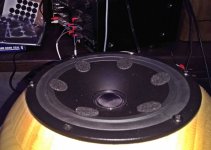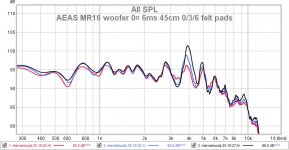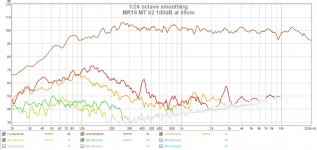Not really. I would say that it was not common knowledge that a parallel notch filter would actually be able to mitigate driver-generated subharmonic distortion on top of just making the system frequency response look nice. I mean the explanation from HiFiCompass makes a lot of sense, but it's kind of mind-blowing (my mind, anyway) in the total scheme of things.
Last edited:
Well, yes, if you're using something like MLS. But if we take another expert's feedback here:Harmonic distortion at the cone breakup frequency is -well- just extra output on the cone breakup frequency. Don‘t bother if it is H2 or H5.
The DSP filtering doesn't work in this case
So if you're expecting the distortion rise due to breakup amplification to be mitigated just because your filter sufficiently slopes down the breakup, it isn't necessarily so in all cases.
HiFiCompass explained it quite well in the other thread.
Some speaker driver measurements... post 1107-1109.
I was surprised at his response as well, and it was one of those "light bulb goes on" moments.
I guess some of us had lost sight of the fact that a passive crossover does more than attenuate the driving signal. It also alters the impedance that the driver motor sees. Any harmonic distortion that is related to the motor can be altered (reduced) by changing the impedance that the voice coil sees.
So while I don't see the need to eat my entire shoe, I have taken a nibble.
Some speaker driver measurements... post 1107-1109.
I was surprised at his response as well, and it was one of those "light bulb goes on" moments.
I guess some of us had lost sight of the fact that a passive crossover does more than attenuate the driving signal. It also alters the impedance that the driver motor sees. Any harmonic distortion that is related to the motor can be altered (reduced) by changing the impedance that the voice coil sees.
So while I don't see the need to eat my entire shoe, I have taken a nibble.
It’s really not what I expect, it’s about reading the/my measurement. Virtually no output on frequency X equals no HD on X/2, X/3 and so on.Well, yes, if you're using something like MLS. But if we take another expert's feedback here:
So if you're expecting the distortion rise due to breakup amplification to be mitigated just because your filter sufficiently slopes down the breakup, it isn't necessarily so in all cases.
An 8th order dsp crossover set at 2khz will take the 5khz resonance peak down about 50db from the reference level, which also means that all distortion artifacts will be reduced that amount. That's probably what would be needed to ensure that the resonance and all the associated harmonic artifacts are completely inaudible when using dsp.
Some interesting info can be gleaned from these measurements, but obviously not all...
NHT Xd active loudspeaker system Measurements | Stereophile.com
Some interesting info can be gleaned from these measurements, but obviously not all...
NHT Xd active loudspeaker system Measurements | Stereophile.com
Last edited:
These measurements show THD on the same Seas drive units @95db/2m(That's loud). Better than nothing🙂
SoundStage! Measurements - NXT Xd Loudspeaker System (7/2006)
Follow up measurements by John Atkinson. Ironically, partly involving the examination of an (incorrectly?) placed notch on the tweeter's ultrasonic resonance.
NHT Xd active loudspeaker system Follow-Up Measurements | Stereophile.com
SoundStage! Measurements - NXT Xd Loudspeaker System (7/2006)
Follow up measurements by John Atkinson. Ironically, partly involving the examination of an (incorrectly?) placed notch on the tweeter's ultrasonic resonance.
NHT Xd active loudspeaker system Follow-Up Measurements | Stereophile.com
Last edited:
HiFiCompass says that filter slopes won't attenuate increased HD from higher sensitivity at breakup. Only a parallel notch in series with driver will.An 8th order dsp crossover set at 2khz will take the 5khz resonance peak down about 50db from the reference level, which also means that all distortion artifacts will be reduced that amount. That's probably what would be needed to ensure that the resonance and all the associated harmonic artifacts are completely inaudible when using dsp.
yes, I saw the Hifi compass comment, but if you look at soundstage's 95db@2meter measurements(Not perfectly analogous to the driver in question, I know) there is, for all intents and purposes, nothing showing up in the THD measurements, which implies that the high order hd has been reduced significantly.
without dsp filtering. Note distortion measurements..
SEAS M15CH-JAM | HiFiCompass
without dsp filtering. Note distortion measurements..
SEAS M15CH-JAM | HiFiCompass
Last edited:
Two things:yes, I saw the Hifi compass comment, but if you look at soundstage's 95db@2meter measurements(Not perfectly analogous to the driver in question, I know) there is, for all intents and purposes, nothing showing up in the THD measurements, which implies that the high order hd has been reduced significantly.
without dsp filtering. Note distortion measurements..
SEAS M15CH-JAM | HiFiCompass
1) the charts don't show anything below -45 dB relative to fundamental
2) high orders generally don't impact THD in any meaningful way since they tend to be much lower levels
I don't think the SoundStage measurements are useful at all in trying to evaluate the impact of crossover filters on the HD peaks.
1) That's 45db down relative to 95db/2m anechoic, which is different than the typical 90db/1m. I'm sure you understand that. The higher the fundamental, the higher the hd is relative to that fundamental.
2) That driver has a 3rd order peak that's only down 26 db from the fundamental at 3khz. If what your saying is true, wouldn't it be very pronounced in the soundstage measurements if the dsp crossover had no effect on hd peaks?
2) That driver has a 3rd order peak that's only down 26 db from the fundamental at 3khz. If what your saying is true, wouldn't it be very pronounced in the soundstage measurements if the dsp crossover had no effect on hd peaks?
I don't know what the audibility treshold of harmonics are and I find it difficult to translate decibels in a forum post to actual in room spl so maybe conduct simple test: listen some music at favourite volume, then turn it down 26db or whatnot to get an idea about the relative spl 🙂 carry on.
edit: quick check with mobile phone, listening at low level music almost disappears. Listening in a normal loudish level, I think might be detectable. Using sine tone, my phone internal speaker audibly distorts from about the - 25db. So, when the system is nearing its limit all problems just pile up when the headroom shrinks. My conclusion is that clean headroom around normal listening level is affected and 26db might not be enough. Sorry the oftopic 🙂
edit: quick check with mobile phone, listening at low level music almost disappears. Listening in a normal loudish level, I think might be detectable. Using sine tone, my phone internal speaker audibly distorts from about the - 25db. So, when the system is nearing its limit all problems just pile up when the headroom shrinks. My conclusion is that clean headroom around normal listening level is affected and 26db might not be enough. Sorry the oftopic 🙂
Last edited:
1% HD (-40dB) in piano music is probably audible, I think. Lower HD numbers are no issue. The early designs with metal cones had a bad reputation on that kind of music, sure the resonance peak was to be blamed. Since sink holes in crossovers became standard, that is not a problem anymore.the charts don't show anything below -45 dB relative to fundamental
I haven't done any rigorous testing myself, but someone whose opinion I hold in high respect noted that they were unable to hear harmonic distortion until almost at 10%, when the distortion was composed of mostly H2 and some H3.1% HD (-40dB) in piano music is probably audible, I think. Lower HD numbers are no issue. The early designs with metal cones had a bad reputation on that kind of music, sure the resonance peak was to be blamed. Since sink holes in crossovers became standard, that is not a problem anymore.
The problem with THD % is that it's majority H2 most of the time and therefore practically useless.
Music and the Human Ear ("Distortion")
Amplifier Distortion Sound Demos
The H3 that peaks at roughly -25 dB (probably worse at the output level in the SoundStage measurements) is at 3 kHz and already sufficiently attenuated by the filter slope, but this is just distortion that is happening outside of the passband. Of course if you don't feed signal to a driver where it performs poorly, it won't perform poorly. But what we're talking about is the sub-multiple (fractional?) distortion amplification that takes place in the passband, which is 9 kHz / 2 = 4.5 kHz H2 (outside passband and therefore irrelevant to our conversation), 9/3 = 3 kHz H3 (similarly out of band), 9/4 = 2.25 kHz (in-band), and 9/5 = 1.8 kHz (in-band).1) That's 45db down relative to 95db/2m anechoic, which is different than the typical 90db/1m. I'm sure you understand that. The higher the fundamental, the higher the hd is relative to that fundamental.
2) That driver has a 3rd order peak that's only down 26 db from the fundamental at 3khz. If what your saying is true, wouldn't it be very pronounced in the soundstage measurements if the dsp crossover had no effect on hd peaks?
As a counter-point, if you look at the H5 peak around -50 dB around 1.8 kHz, I would expect it to be present at the same level (unless there actually is a passive parallel notch in the speaker) since it's within the passband but pretty hard to tell since it's just below the cutoff. There is a bit of a rise in visible THD starting around 2 kHz in the SoundStage measurements but I'm guessing that's from the H3 right before the low-pass filter kicks in.
NHS XdS Measurements and Analysis | Audioholics
Last edited:
Noob's question about the Seas W22.
This h5 1k hz and h4 1.4k hz peaks don't also show poor IMD there as Zaph seems to suggest in the reading methodology of his measurements ?
Which suggests to cut-off below 1k hz with something stiff, LR4 for instance ? (LR2 ?)
I also don't understand why he says to cut as high the W17 little brother as well ?
If you look at HifiCompass measurements of the SB23NAC45-8, you can see also raise of H5 as low as600/700 hz and whatever the ribs. Break-ups beginning lower than 2k at h3 measurements...
SB Acoustics SB23NACS45-8 | HiFiCompass
Asking myself if someone tried to damp a little with natural shellac toward the center of the cone and/or metal dust cap - don't know if there is some acidity in shellac ?... or putt a mushroom resonator above the cone as they do for hard dome tweeter ? Or a f-shirt felt in front of the driver as suggested before which is a raising Z attenuation as the frequencies climb?
Now if those low H5 & H4 are too huge IMD at 1k or lower, what one could do but lowering the cut-off even lower ???
Me has the SB23NBAC45-8 version and I plan something like a LR2 as low as 500 or 600 hz... perhaps not enough stiff !
This h5 1k hz and h4 1.4k hz peaks don't also show poor IMD there as Zaph seems to suggest in the reading methodology of his measurements ?
Which suggests to cut-off below 1k hz with something stiff, LR4 for instance ? (LR2 ?)
I also don't understand why he says to cut as high the W17 little brother as well ?
If you look at HifiCompass measurements of the SB23NAC45-8, you can see also raise of H5 as low as600/700 hz and whatever the ribs. Break-ups beginning lower than 2k at h3 measurements...
SB Acoustics SB23NACS45-8 | HiFiCompass
Asking myself if someone tried to damp a little with natural shellac toward the center of the cone and/or metal dust cap - don't know if there is some acidity in shellac ?... or putt a mushroom resonator above the cone as they do for hard dome tweeter ? Or a f-shirt felt in front of the driver as suggested before which is a raising Z attenuation as the frequencies climb?
Now if those low H5 & H4 are too huge IMD at 1k or lower, what one could do but lowering the cut-off even lower ???
Me has the SB23NBAC45-8 version and I plan something like a LR2 as low as 500 or 600 hz... perhaps not enough stiff !
Last edited:
A 3-way speaker's woofer can always be crossed so low that cone resonance won't be a problem. 2-way woofer or midrange is when there might be a problem.
In a project I used felt pads to tame polycone's resonance. Sorry I didn't save these measurements, so distortion profile change is a mystery...
https://www.diyaudio.com/forums/multi-way/322839-seas-mr18-3-a-3.html#post5612476
In a project I used felt pads to tame polycone's resonance. Sorry I didn't save these measurements, so distortion profile change is a mystery...
https://www.diyaudio.com/forums/multi-way/322839-seas-mr18-3-a-3.html#post5612476
Attachments
- Home
- Loudspeakers
- Multi-Way
- cone breakup


